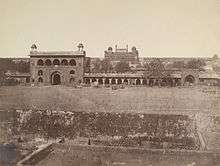Naubat Khana (Red Fort)
Coordinates: 28°39′21″N 77°14′28″E / 28.655774°N 77.240991°E

The Naubat Khana, or Naqqar Khana, is the drum house that stands at the entrance between the outer and inner court at the Red Fort in Delhi.
The vaulted arcade of the Chhatta Chowk measures 540 x 360 feet, and ends in the centre of the outer court.[1] The side arcades and central tank were destroyed following the 1857 rebellion.
In the east wall of the court lies the Naubat Khana, which was connected to the side arcades. Musicians from the Naubat Khana would announce the arrival of the emperor and other dignitaries at the court of public audience (Diwan-i-Am). Music was also played five times a day at chosen hours. Many Indian royal palaces have a drum house at the entrance.[2]
Some historians believe that the later Mughal emperors Jahandar Shah (1712–13) and Farrukhsiyar (1713–19) were assassinated here.[2]
The popular name of the gate, Hathiyan pol or "elephant gate," derives from the tradition that everyone except princes of the royal blood had to dismount from their elephants at this point, before entering further into the inner fort complex.[2]
The ground plan is a rectangular structure consisting of three large stories. The band gallery is 100 x 80 feet.[1] The construction material is red sandstone, the surface covered in white chunam plaster. The richly carved floral designs on its red sandstone walls appear to have been originally painted with gold. The interior was colourfully painted. Several layers of these paintings can be found at the entrance chamber.[2]
The British initially installed the museum of the fort in this gate. It was later moved to the Mumtaz Mahal. The Indian War Memorial Museum is currently located in the first and second stories.
References
- 1 2 Murray, John (1911). A handbook for travellers in India, Burma, and Ceylon (8th ed.). Calcutta: Thacker, Spink, & Co. p. 197. ISBN 978-1175486417. Retrieved 2014-01-25.
- 1 2 3 4 "Naubat or Naqqar Khana of Red Fort". Archaeological Survey of India. 2011. Retrieved 2013-12-09.
Literature
- Koch, Ebba. 1991. Mughal Architecture. Munich: Prestel, 111.
- Mukherji, Anisha Shekhar. 2003. The red fort of Shahjahanabad. Delhi ; Oxford: Oxford University Press.
- Tillotson, G.H.R. 1990. Mughal India. San Francisco: Chronicle Books, 57-8.
External links
![]() Media related to Naubat Khana (Red Fort) at Wikimedia Commons
Media related to Naubat Khana (Red Fort) at Wikimedia Commons